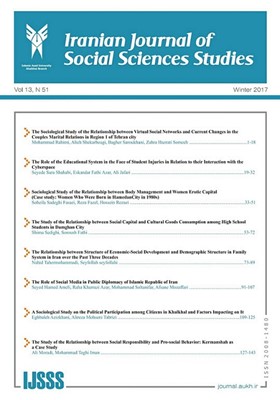The relationship between informal social links network and mental health ( study of case: comparison of women and men employed in Iran Teransfo corporation in the Zanjan
Subject Areas : Familymahbobeh babaee 1 * , Lila Jaleh Abdullahi 2
1 - Assistant Professor, Department of Social Sciences, Zanjan Branch, Islamic Azad University, Zanjan, Iran
2 - Master of social researcher, Department social science, Zanjan Branch, Islamic Azad university, Iran
Keywords: mental health, Informal social links, network social capital,
Abstract :
The present study aims to determine the relationship between the informal social links and mental health of the employees of Iran Transfo Corporation in Zanjan .(based on gender).The theoretical framework is an integration of the analysis of the social experts'' views on the social capital of the network (Bart, et.al). The method of this research is descriptive-analytic, and the method of data collection is analytical survey and the instrument is a questionnaire. The population is 1800 subjects and the sample size is 316 using the Cochran formula. The sampling method was simple random sampling. For data analysis, SPSS software was used and descriptive statistics and inferential statistical tests were used for measuring variables. The findings of the study using independent t-tests, one-way ANOVA and Pearson''s correlation coefficient shows that: 1- range of links, the severity of links, receiving support, support provision in the informal links network, gender, age, education, marital status, number of children and organizational posts have a significant relationship with mental health 2. Based on the results of independent t-test, men have more mental health than women, and men also enjoy more support provision, receiving support, support severity, and more link range than women. 3. In total, the coefficient of determination of the path analysis was 0.67. This means that the variables considered determine 69.7% of variance of dependent variable, and 30.3% of variance of dependent variable is related to variables that are not predicted in this research.
_||_

